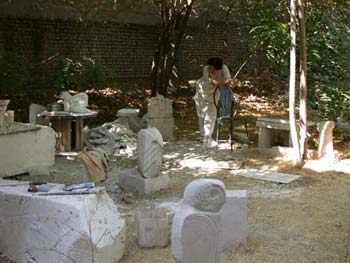Upon the first look at the statuary of Simin Ekrami, without knowing her gender, one’s immediate gut feeling is that these works are reflections of the personality, outlook, viewpoint, and feminine joy of an extraordinary woman.
A perfect woman in the truest sense and meaning of the word, the mother of two children and the spouse of Bahram Dabiri, the painter…..A husband and wife who, without considering the wishes of their parents, lovingly chose one another and have managed to make a good joyous and healthy living out of their chosen artistic vocations.
Simin and Bahram have always maintained an open house policy towards guests and everyone is always welcomed into their home where they are entertained and served in a warm pleasant manner.

In Simin Ekrami’s statuary, the first thing that clearly attracts attention is femininity, independence and emancipation. From her work, one can easily discern and identify the principles to which she adheres and arise from her personal life-experiences. Those who know Simin well also know that since her youth she has always held certain heartfelt beliefs which are in fact cultural, including a deep love and appreciation for the green growing blooming Mother-Nature, hope, peace and friendship.
Simin Ekrami works with wood, stone and bronze, just like our ancestors whose working tools were stone, wood and metal and used a method in sculpting which lasted at least until the end of 19th century before being transformed and thus finding a new meaning by modern changes brought about in the course of twentieth century. It is enough to look at volumes 33-36 of Natural History and the chapters pertaining to sculpture to find out how our ancestors used to work. How much they took sculpture seriously and how is it possible to identify the culture of a nation from its statuary. Statues represent human rituals, believes, philosophy, ideas as well as his faith in metaphysics. We find significant divisions of the work of past masters in various chapters of the aforementioned book; clay figures in the chapter on soil, marble statutes in the chapter on stone and bronze ones in the corresponding chapter, metal. Each one of these chapters refers to a part of archaeology of cultures and traditions of various people and nations, the rituals and ceremonies of civilization in various eras. For example, marble has attracted attention for its decorative function. Porphyry and different types of stones were used for tombs and mausoleums, ceramic for temples, bronze for appreciation and reverence of men and women in special social positions.
Simin Ekrami’s wooden works whether in large or small sizes, reflect the living spirit and the reality hidden in the heart of Life. In these works she is not after mere beauty, beauty for the sake of beauty. Her stone statutes, particularly her birds represent Simin’s firm belief in tranquility, peace and friendship. Have you seen her pigeons? Simin’s stone pigeons, creatures born out of stone are light, animate and free; free of heaviness, density and harshness of stone as well as life! That’s why you automatically wish to call them ‘juju’ as Iranian children call birds.
Simin Ekrami is a ‘materialist sculptor,’ a real materialist both in thought and in deed. She has remained faithful to the Sumerian principles of five thousand years ago. The course of sculpture from Sumeria to Egypt, later to ancient Greece and Rome and its periodic re-emergence under Renaissance in Italy and Europe, a course of development with Iran playing a prominent role in its birth.
Simin Ekrami is an animator of this tradition, reviving it in an ever more majestic way. The influence of Sumerian sculpture can easily be traced in ancient Iranian jewelries. The remaining pieces of this art are the evidence, an art which traveled from Iran to Egypt and Anatolia (today’s Turkey), later to Greece and Rome. Although the Greek changed it according to their own taste, so did any other civilization which absorbed it, yet with every new change it found a new beauty.
The major lines of any civilization can be read in its statuary. We identify the glory of the tenth century Indian civilization in the statutes remaining in Hindu temples. In the same way, works finding their way from Africa and Oceania into European market in the twentieth century had a great influence on modern European artistic movements and trends.
Simin has pursued a definite goal and leaving a message in every single work she has created. Her creations are not merely sculpture for the sake of sculpture. The same goal-oriented approach can be clearly found in all the past civilizations. In Greece, statutes belonged to gods and the method followed in their creations was to suggest the divinity of gods. In other words, the attention of their creators was all focused on the celestial and spiritual aspects of their statuary. Similarly, Iranian works of arts, particularly the eternal bas-reliefs of Persepolis, represent divine majesty and splendor; the belief in fairies and goblins are reflected in statuary of Oceania and similarly the secret of metaphysical world can be traced in African works. None of these works have a decorative aspect; instead they rather represent that concealed hidden perfect part of human existence.
Similarly, in my opinion Simin Ekrami has never sought to create just a piece of decorative art. Whether in her stone, wooden or metallic statutes, she has always followed a definite path and a clear method of expression.
Kaveh Vafadari
2007